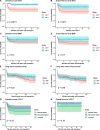Optimizing diagnostic methods and stem cell transplantation outcomes in pediatric bone marrow failure: a 50-year single center experience
- PMID: 37439851
- PMCID: PMC10570154
- DOI: 10.1007/s00431-023-05093-y
Optimizing diagnostic methods and stem cell transplantation outcomes in pediatric bone marrow failure: a 50-year single center experience
Abstract
Peripheral blood cytopenia, a frequent presenting symptom in pediatric patients, can be caused by bone marrow failure (BMF). Timely identification of patients with non-reversible BMF is of crucial importance to reduce the risks of invasive infections and bleeding complications. Most pediatric patients with severe persistent cytopenia, independent of the underlying cause, are offered allogeneic hematopoietic stem cell transplantation (HSCT) as curative therapy. Here we report on our management guidelines and HSCT outcomes of pediatric BMF patients to pinpoint improvements and future challenges. We formulated recommendations based on this 50 years' experience, which were implemented at our center in 2017. By analysis of the HSCT cohort of 2017-2023, the 5-year outcome data is presented and compared to historical outcome data. In addition, outcomes of patients transplanted for identified inherited bone marrow failure syndromes (IBMFS) are compared to severe aplastic anemia (SAA) outcomes to underline the often multiorgan disease in IBMFS with implications for long-term survival. Survival of pediatric patients with irreversible BMF has improved tremendously. SAA patients transplanted after 2017 had a superior 5-year overall (OS) and event-free survival (EFS) of 97% and 85% compared to 68% and 59% in the cohort transplanted before 2017 (p = 0.0011 and p = 0.017). A similar trend was seen for BMF, with an OS and EFS of 89% for those transplanted after 2017 compared to 62% and 59% (p > 0.05). This improvement is mainly related to better survival in the first months after HSCT. The long-term survival after HSCT is lower in IBMFS patients as compared to SAA patients due to secondary malignancies and multiorgan toxicity. Conclusion: Unbiased protocolized in-depth diagnostic strategies are crucial to increase the frequency of identifiable causes within the heterogeneous group of pediatric BMF. A comprehensive approach to identify the cause of BMF can prevent treatment delay and be useful to tailor treatment and follow-up protocols. What is Known: • Irreversible BMF in pediatric patients can be caused by a wide spectrum of underlying diseases including (pre)malignant disease, IBMFS and AA. Identifying the exact underlying cause of BMF is crucial for tailored therapy, however often challenging and time-consuming. • Frontline allogeneic HSCT is offered to most pediatric patients with severe BMF as curative treatment. What is New: • Protocolized unbiased diagnostics, short time to treatment (< 3 months) and maximal supportive care until curative treatment can prevent complications with a negative effect on survival such as infection and bleeding. • Personalized follow-up protocols for IBMFS patients are essential to prevent a second decline in survival due to long-term treatment toxicity and extra-hematological disease complications.
Keywords: Aplastic anemia; Bone marrow failure; Cytopenia; Hematopoietic stem cell transplantation; Immune suppressive therapy; Molecular analysis.
© 2023. The Author(s).
Conflict of interest statement
The authors declare no competing interests.
All authors declared no potential conflicts of interest with respect to the research, authorship, and/or publication of this article. All authors approved the final manuscript as submitted and agree to be accountable for all aspects of the work. The authors have no financial relationships relevant to this article to disclose.
Figures



Similar articles
-
Pediatric Bone Marrow Failure: A Broad Landscape in Need of Personalized Management.J Clin Med. 2023 Nov 20;12(22):7185. doi: 10.3390/jcm12227185. J Clin Med. 2023. PMID: 38002797 Free PMC article. Review.
-
Diagnostic Value of a Protocolized In-Depth Evaluation of Pediatric Bone Marrow Failure: A Multi-Center Prospective Cohort Study.Front Immunol. 2022 Apr 27;13:883826. doi: 10.3389/fimmu.2022.883826. eCollection 2022. Front Immunol. 2022. PMID: 35572556 Free PMC article.
-
Current Knowledge and Priorities for Future Research in Late Effects after Hematopoietic Cell Transplantation for Inherited Bone Marrow Failure Syndromes: Consensus Statement from the Second Pediatric Blood and Marrow Transplant Consortium International Conference on Late Effects after Pediatric Hematopoietic Cell Transplantation.Biol Blood Marrow Transplant. 2017 May;23(5):726-735. doi: 10.1016/j.bbmt.2017.01.075. Epub 2017 Jan 20. Biol Blood Marrow Transplant. 2017. PMID: 28115275 Free PMC article. Review.
-
[Molecular diagnosis and hematopoietic stem cell transplantation in 17 children with inherited bone marrow failure syndrome].Zhonghua Er Ke Za Zhi. 2015 Nov;53(11):817-23. Zhonghua Er Ke Za Zhi. 2015. PMID: 26758319 Chinese.
-
Current use of androgens in bone marrow failure disorders: a report from the Severe Aplastic Anemia Working Party of the European Society for Blood and Marrow Transplantation.Haematologica. 2024 Mar 1;109(3):765-776. doi: 10.3324/haematol.2023.282935. Haematologica. 2024. PMID: 37199126 Free PMC article.
Cited by
-
Potential role of B- and NK-cells in the pathogenesis of pediatric aplastic anemia through deep phenotyping.Front Immunol. 2024 Aug 20;15:1328175. doi: 10.3389/fimmu.2024.1328175. eCollection 2024. Front Immunol. 2024. PMID: 39229270 Free PMC article.
-
The state of the art in the treatment of severe aplastic anemia: immunotherapy and hematopoietic cell transplantation in children and adults.Front Immunol. 2024 Apr 5;15:1378432. doi: 10.3389/fimmu.2024.1378432. eCollection 2024. Front Immunol. 2024. PMID: 38646536 Free PMC article. Review.
-
Understanding Rare Anemias: Emerging Frontiers for Diagnosis and Treatment.J Clin Med. 2024 May 29;13(11):3180. doi: 10.3390/jcm13113180. J Clin Med. 2024. PMID: 38892889 Free PMC article. Review.
-
Pediatric Bone Marrow Failure: A Broad Landscape in Need of Personalized Management.J Clin Med. 2023 Nov 20;12(22):7185. doi: 10.3390/jcm12227185. J Clin Med. 2023. PMID: 38002797 Free PMC article. Review.
References
MeSH terms
LinkOut - more resources
Full Text Sources
Medical

